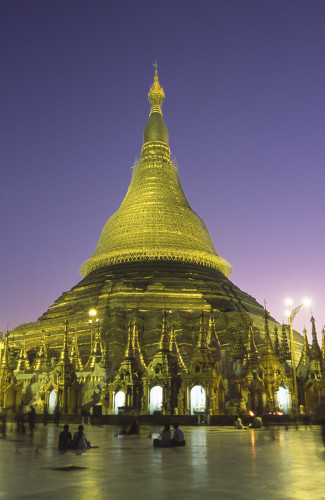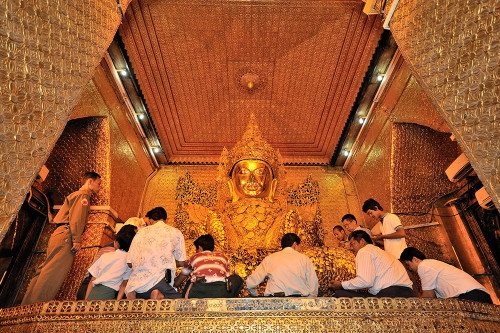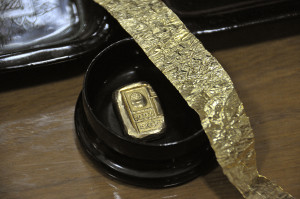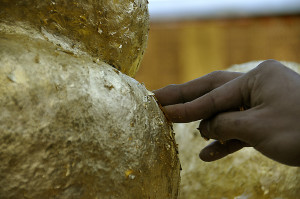Burma’s jungles hide fabulous reserves of precious stones. Mines around the town of Mogok in Mandalay Division produce much prized “pigeon’s blood” rubies and beautiful sapphires. In Kachin State, Hpakant’s vast open-pit mines – visible on Google Earth – produce the world’s finest jadeite. And yet, rather than “Land of Rubies” or “Land of Jade”, Burma is known as the “Land of Gold”.
One reason, at least, is obvious from a casual walk around any Burmese town or village. Keep your eyes open, and the chances are that within a couple of minutes you’ll either spot the burnished gold of a pagoda at street-level, or see one glinting from a nearby hilltop.
Burma’s paya – a word usually translated as “pagoda”, although the majority resembles stupas more than Chinese-style pagodas – are almost universally covered with gold leaf or gold paint. Coating and recoating religious buildings with gold is one of the best ways for the building’s sponsors to earn religious merit.
Elsewhere, the gold covering is more of a collective effort, with worshippers queuing to buy tiny squares of delicate gold leaf sandwiched between sheets of tissue. Mandalay’s Mahamuni Buddha is a good example; the lower part of this revered Buddha statue, believed to be one of a handful cast during Buddha’s lifetime, has slowly been obscured by layers of gold leaf applied by male devotees (women must watch the action on a television screen outside). The gold is now estimated to be between 20–30cm or almost 12 inches thick!
One of the most fascinating places I visited on my research trip to Burma was one of Mandalay’s gold leaf workshops. Considered a sacred craft, the leaves are handmade by a process that has changed little for centuries. First, an ounce of gold is placed in a bamboo paper wrapper and pounded with a heavy hammer for 30 minutes before being cut into six smaller pieces. These pieces are then stacked and the process is repeated again and again until the sheet reaches the requisite thinness, as you can see in the following video:
Crafting gold leaves is hard, but it pays well and, according to Buddhist tradition, buys good karma. Only men are allowed to do the hammering, taking up the job at the age of 16 and retiring in their mid-forties when their bodies can no longer endure the work. Women work at cutting the gold leaves, a less respected role than the men’s. Both men and women work in stuffy, wind- and draught-proof rooms to cut the feathery sheets of gold leaf into smaller pieces.
The second and less immediately obvious reason behind Burma’s golden nickname is that both the Burmese and the Mon believe that a region of Lower Burma was once the site of Suvarnabhumi, a “Golden Land” mentioned in early Buddhist texts.
The town of Thaton in Mon State is supposed to have sat at Suvarnabhumi’s heart. Once the capital of a wealthy Mon kingdom, today Thaton is a sleepy little market town, where the only signs of a “golden land” are the pagodas that glint from the ridge behind the town, and the large Shwe Saryan pagoda complex next to the bus station.
As you can see, both of the reasons why Burma is known as the “Land of Gold” are intimately connected to its people’s strong Buddhist faith. Another story I was told during my trip attests to this strong link: many Burmese families do not have savings accounts, not because they don’t have any money to save, but rather because any surplus each month is spent on gold leaf and stuck on temple statues – savings for the next life, rather than this one, as it were…
Please click this link to our “A Burmese Journey – From the Golden Triangle to the Bay of Bengal”, that features a visit to a gold leaf workshop in Mandalay.



